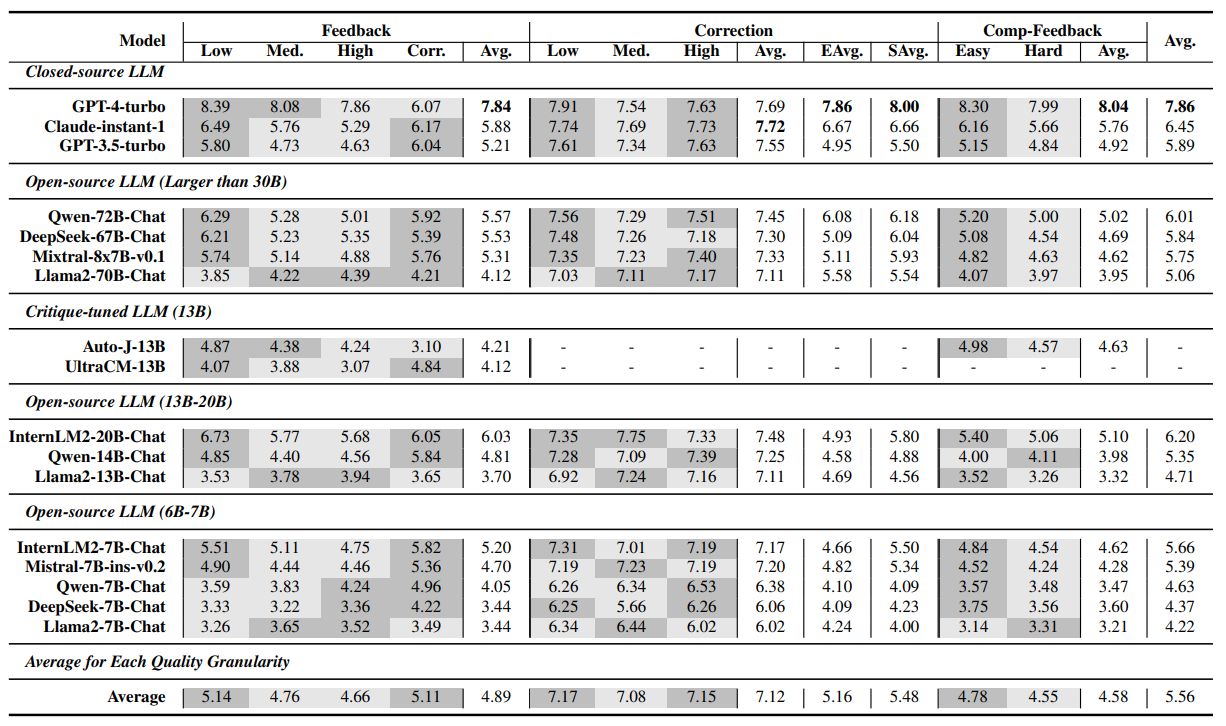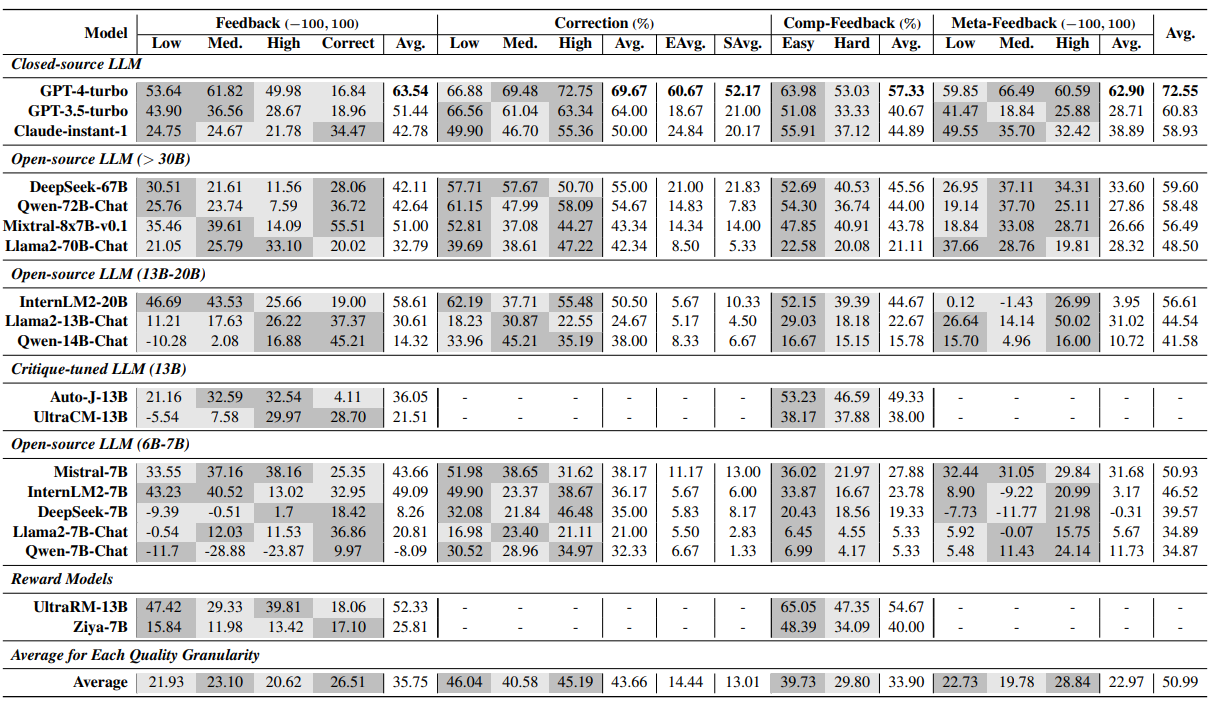This repository is the official implementation of CriticBench, a comprehensive benchmark for evaluating critique ability of LLMs.
CriticBench: Evaluating Large Language Models as Critic
Tian Lan1*,
Wenwei Zhang2*,
Chen Xu1,
Heyan Huang1,
Dahua Lin2,
Kai Chen2†,
Xian-ling Mao1†
(† Corresponding Author, * Equal Contribution)
1 Beijing Institute of Technology, 2 Shanghai AI Laboratory
[Dataset on HF] [Project Page] [Subjective LeaderBoard] [Objective LeaderBoard]
Critique ability are crucial in the scalable oversight and self-improvement of Large Language Models (LLMs). While many recent studies explore the critique ability of LLMs to judge and refine flaws in generations, how to comprehensively and reliably measure the critique abilities of LLMs is under-explored. This paper introduces CriticBench, a novel benchmark designed to comprehensively and reliably evaluate four key critique ability dimensions of LLMs: feedback, comparison, refinement and meta-feedback. CriticBench encompasses nine diverse tasks, each assessing the LLMs' ability to critique responses at varying levels of quality granularity. Our extensive evaluations of open-source and closed-source LLMs reveal intriguing relationships between the critique ability and tasks, response qualities, and model scales.
- [2024.2.21] Release paper, codes, data and other resources of CriticBench v1.3.
- Evaluate Qwen-1.5 series models
- Improve the reliability of subjective evaulation in CriticBench (v1.4)
- Expand to more diverse tasks
- Expand to Chinese applications
- Prepare and clean the codebase for OpenCompass
- Release the train set of CriticBench
- Support inference on Opencompass.
Download the dataset from huggingface dataset by running this command:
mkdir data
cd data
git clone https://huggingface.co/datasets/opencompass/CriticBenchwhich get into the data folder and clone the CriticBench dataset.
Note that the human-annotated Likert scores, preference labels, and critiques in test set are excluded.
You can submit your inference results on the test set (via run codes under inference folder) to this email. We will run your predictions and update the results in our leaderboard. Please also provide the scale of your tested model.
The structure of your submission should be similar to that in example_data.
git clone https://github.com/open-compass/CriticBench.git
# prepare the env for evaluation toolkit
cd critic_bench
pip install -r requirements.txt
# prepare the env for LLM inference
cd ../inference
pip install -r requirements.txtYou need to inference LLMs to be evaluated on our proposed CriticBench, and generation results on CriticBench can be found in inference/outputs folder.
If you are interested with our prompts for LLM, they are shown in inference/utils/prompts.py.
Specifically, the inference code should be like:
# this line loads all the evaluation dataset in CriticBench from `inference/utils`
datasets = load_all_datasets(args['data_dir'])
# these lines init the tokenizer and models from huggingface
tokenizer = AutoTokenizer.from_pretrained(
args['model_name'],
trust_remote_code=True
)
model = AutoModelForCausalLM.from_pretrained(
args['model_name'],
device_map="auto",
trust_remote_code=True
).cuda().eval()
...
# inference the LLM and save the results in json file format
for abbr, dataset in tqdm(datasets.items()):
path = os.path.join(folder_path, abbr + ".json")
results = {}
for item in tqdm(dataset['dev']):
# If you want to inference other LLMs, please revise this line
response, history = model.chat(tokenizer, item['question'], history=[])
results[str(len(results))] = {
'origin_prompt': item['question'],
'prediction': response
}
# save the results into json file, with the abbr as the file name
with open(path, 'w') as f:
json.dump(results, f, ensure_ascii=False, indent=4)We only provide the inference codebase for our InternLM2-7B-Chat, but it is easy to revise the inference code for evaluating your own LLMs (more details are in inference/internlm2.py).
We have already released the generation results of some representative LLMs on CriticBench, and you could found them in example_data/prediction_v1.3.tgz.
tar -xzvf example_data/prediction_v1.3.tgzAfter unzipping, you could found the details of the predictions of LLMs on CriticBench. Typically, the format of the evaluation files are: {split}_{domain}_{dimension}_{format}.json, where split, dimension, and format are described above. The domain represents 9 task scenarios in our proposed CriticBench, consisting of translate, chat, qa, harmlessness, summary, math_cot, math_pot, code_exec, code_not_exec. Refer to more details in our paper.
Here are some notes:
- the
comp_feedbackcritique dimension always company with anreversefile which is used to address the well-known positional bias problem for LLM-as-a-judge procedure. Refer to more details in Section 4 of our paper. - For
feedbackcritique dimension, eachdomainhas additional*_correction_part.jsonfiles, saving the evaluation results of critiques for the correct or the very high-quality responses. Refer to more details about these response in our paper.
The format of the evaluation result file is:
{
'0': {
'origin_prompt': 'The original prompt for LLMs to be evaluated',
'prediction': 'The generated critiques to be evaluated'
}
}After getting the generation results under inference/outputs, your next step is to compute the objective and subjective scores in our proposed CriticBench using our toolkit.
See more details about the objective and subjective scores in Section 4 of our paper.
We provide two ways for computing the objective and subjective scores in critic_bench folder.
- Objective scores could be computed automatically without any cost
- Subjective scores rely on the advanced GPT-4-turbo model for automatic evaluation
It is easy to compute the scores by running following commands.
Before running this code, please make sure that your own OpenAI API key in critic_bench/run.sh is set.
export OPENAI_API_KEY=...Then, running the following codes for evaluation:
./run.sh <dimension> <format> <split> <save_dir>dimensiondenotes critique dimensions defined in our proposed CriticBench, which arefeedback,correction,comp_feedback, andmeta_feedback. Refer to more details about these critique dimensions in Section 2 of our paper.formatdenotes the critique formatobjectiveandsubjective. Objective scores are spearman correlation, pass rate, preference accuracy that can be computed automatically without any cost, while subjective scores are computed by prompting GPT-4-turbo to compare generated critiques and our human-annotated high-quality critiques in CriticBench.splitdenotes thetestordevset to be evaluated.save_diris any text path saving the evaluation results.
In run.sh file, you could find the corresponding commands for objective and subjective evaluation process. For example, for the feedback critique dimension, the objective evaluation is like:
python run_feedback.py --root_dir "../data/CriticBench" --prediction_dir "../example_data/prediction_v1.3" --split $3 --obj Trueroot_dircontains the path of thetestanddevset in CriticBench.prediction_dircontains the inference results of LLMs to be evaluated. We also provide the inference results of some representation LLMs inexample_data. If you want to evaluate your own LLMs, please refer toinference/README.mdfor more details, and theprediction_dircould be set as../inference/outputs.splitdenotes whether thetestor thedevset is used.objdenotes that the objective evaluation is activated
For the subjective evaluation of the feedback critique dimension, the evaluation command is like:
python run_feedback.py --root_dir "../data/CriticBench" --prediction_dir "../example_data/prediction_v1.3" --evaluation_dir "../example_data/evaluation_v1.3/" --batch_size 1 --split $3 --obj Falseevaluation_dirsaves the subjective evaluation scores of GPT-4, which can be re-loaded if the subjective evaluation process borke off. The order of the samples in each file inevaluation_dirfollows the order in the original data in CriticBench (data/CriticBench).batch_sizecontrols the number of the process for access GPT-4 API under multiprocessing setting.
The evaluation results of GPT-4 under save_dir is jsonl, and each line contains the evaluation results. The chain-of-thought evaluation results prompted by GPT-4 is in the evaluation key-value in each line, which is a dict consisting of the chain-of-thought rationale about GPT-4 (key-value cot) and a Likert score (key-value score) for each critiques, ranging from 1 to 10.
- 1 denotes the worst performance
- 10 denotes the best performance
- 8 denotes the comparable performance with our human-annotated high-quality critiques, and scores higher than 8 denotes the better performance of evaluated critiques.
The subjective evaluation results of some representation LLMs are shown:
The objective evaluation results of some representation LLMs are shown:
Refer to our Project Page for the complete evaluation results on CriticBench.
CriticBench is built with OpenCompass. Thanks for their awesome work!
The quota for API-based LLMs are supported by Beijing Institute of Technology and Shanghai AI Laboratory. Thank you so much!
- Tian Lan: lantiangmftby@gmail.com
- Wenwei Zhang: zhangwenwei@pjlab.org.cn
@misc{lan2024criticbench,
title={CriticBench: Evaluating Large Language Models as Critic},
author={Tian Lan and Wenwei Zhang and Chen Xu and Heyan Huang and Dahua Lin and Kai Chen and Xian-ling Mao},
year={2024},
eprint={2402.13764},
archivePrefix={arXiv},
primaryClass={cs.CL}
}
This project is released under the Apache 2.0 license.




